
Cajun cuisine is a style of cooking developed by the Cajun–Acadians who were deported from Acadia to Louisiana during the 18th century and who incorporated West African, French and Spanish cooking techniques into their original cuisine.

KFC is an American fast food restaurant chain headquartered in Louisville, Kentucky, that specializes in fried chicken. It is the world's second-largest restaurant chain after McDonald's, with 22,621 locations globally in 150 countries as of December 2019. The chain is a subsidiary of Yum! Brands, a restaurant company that also owns the Pizza Hut and Taco Bell chains.
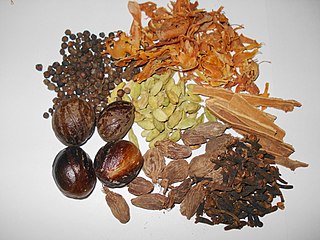
Spice mixes are blended spices or herbs. When a certain combination of herbs or spices is called for in a recipe, it is convenient to blend these ingredients beforehand. Blends such as chili powder, curry powder, herbes de Provence, garlic salt, and other seasoned salts are traditionally sold pre-made by grocers, and sometimes baking blends such as pumpkin pie spice are also available. These spice mixes are also easily made by the home cook for later use.
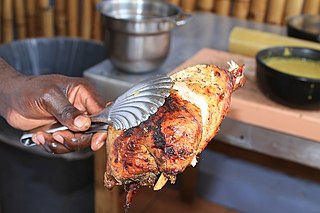
Jerk is a style of cooking native to Jamaica, in which meat is dry-rubbed or wet marinated with a hot spice mixture called Jamaican jerk spice.
A secret ingredient is a component of a product that is closely guarded from public disclosure for competitive advantage. Sometimes the ingredient makes a noticeable difference in the way a product performs, looks or tastes; other times it is used for advertising puffery. Companies can go to elaborate lengths to maintain secrecy, repackaging ingredients in one location, partially mixing them in another and relabeling them for shipment to a third, and so on. Secret ingredients are normally not patented because that would result in publication, but they are protected by trade secret laws. Employees who need access to the secret are usually required to sign non-disclosure agreements.
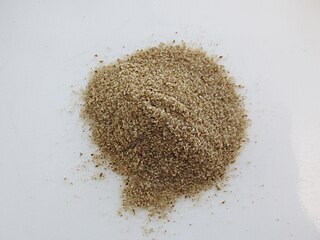
Celery salt is a seasoned salt used to flavour food. The primary ingredient is table salt and the flavouring agent is ground seeds from celery or its relative lovage. It is also sometimes produced using dried celery or seed oleoresin.

Tunisian cuisine, the cuisine of Tunisia, consists of the cooking traditions, ingredients, recipes and techniques developed in Tunisia since antiquity. It is mainly a blend of Mediterranean and native Punics-Berber cuisine. Historically, Tunisian cuisine witnessed influence and exchanges with many cultures and nations like Italians, Andalusians, French and Arabs.

Fried chicken, also known as Southern fried chicken, is a dish consisting of chicken pieces that have been coated with seasoned flour or batter and pan-fried, deep fried, pressure fried, or air fried. The breading adds a crisp coating or crust to the exterior of the chicken while retaining juices in the meat. Broiler chickens are most commonly used.
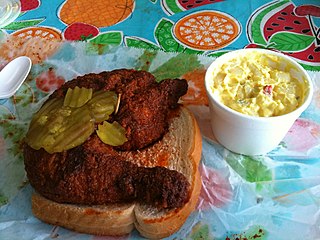
Hot chicken is a type of fried chicken that is a local specialty of Nashville, Tennessee, in the United States. In its typical preparation, it is a portion of breast, thigh or wing that has been marinated in a water-based blend of seasoning, floured, fried and finally covered in a paste or sauce that has been spiced with cayenne pepper. This method of preparation originates within African American communities in the Southern United States. A richly pigmented seasoning paste gives the fried chicken its reddish hue. Spice blends, preparation methods and heat intensity vary from recipe to recipe or depending on the chef.

ColonelHarland David Sanders was an American businessman and founder of fast food chicken restaurant chain Kentucky Fried Chicken. He later acted as the company's brand ambassador and symbol. His name and image are still symbols of the company.

The Harland Sanders Café is a historic restaurant located in North Corbin, Kentucky. Colonel Harland Sanders, the founder of Kentucky Fried Chicken, operated the restaurant from 1940 to 1956. Sanders also developed the famous KFC secret recipe at the café during the 1940s. It was added to the National Register of Historic Places on August 7, 1990.

Winston Laverne Shelton was an American inventor, electrical engineer and entrepreneur who was awarded 76 US patents as an individual or as part of a team, as well as many corresponding patents. Shelton's patents have had an impact relating to home washing machines and the preparation of food in both the Quick Service Restaurant (QSR) industry and fine dining. Technologies Shelton developed while an engineer at General Electric are still in use after more than fifty years. His patent for the modern "Washing Machine", licensed in 1965 to General Electric has been referenced in over 40 subsequent patents.

KFC was founded by Colonel Harland Sanders, an entrepreneur who began selling fried chicken from his roadside restaurant in Corbin, Kentucky, during the Great Depression. Sanders identified the potential of restaurant franchising, and the first "Kentucky Fried Chicken" franchise opened in Salt Lake City, Utah, in 1952. KFC popularized chicken in the fast-food industry, diversifying the market by challenging the established dominance of the hamburger. Branding himself "Colonel Sanders", the founder became a prominent figure of American cultural history, and his image remains widely used in KFC advertising. The company's rapid expansion made it too large for Sanders to manage, so in 1964 he sold the company to a group of investors led by John Y. Brown Jr. and Jack C. Massey.
KFC has been an extensive advertiser since the establishment of the first franchise in 1952.

Mala is a spicy and numbing seasoning made from Sichuan peppercorn and chilli. Most commonly, mala is made into a sauce by simmering it in oil and other spices. Characteristic of Sichuan cuisine, particularly Chongqing cuisine, it has become one of the most popular ingredients in Chinese cuisine, spawning many regional variants.

Hui mian is a Henan-style noodle soup. The ingredients used in the dish vary across different cities and restaurants. Typically, hui mian is made with lamb bones and a range of Chinese herbs, such as lycium chinense and star anise. However, kelp, tofu, coriander, quail eggs, chili oil, sugar, garlic, and minced peppers are also common ingredients.
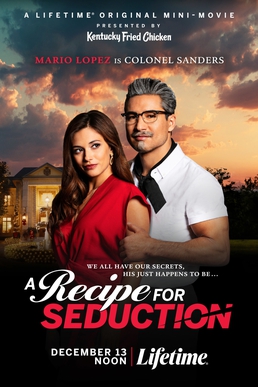
A Recipe for Seduction is a short film sponsored by KFC and produced by the Lifetime Channel, starring Mario Lopez as Colonel Sanders. The movie premiered on December 13, 2020. It tells the story of a young heiress who struggles to choose between a wealthy suitor chosen by her mother, and the new house chef Harland Sanders.

Oliver George Gleichenhaus named the "re-inventor" of the hamburger, was an American restaurateur, best known for his small North Miami Beach, Florida, restaurant "Ollie's Sandwich Shop", located at Third Avenue and 23rd Street, where in the mid-1930s, he created his signature "Ollie Burger" which he prepared with his secret blend of 23 herbs and spices. Extremely profane and irascible, Gleichenhaus was known to curse at and eject diners who requested condiments like ketchup to add to his "perfect burgers".
KFC rice—also known as devil cooked rice, devil's takikomi gohan, Kentucky takikomi gohan, and KFC takikomi gohan —is a variation of takikomi gohan which utilizes fried chicken. It is prepared in a rice cooker. The rice is often mixed with chicken stock and soy sauce before adding the fried chicken. Per its name, the fried chicken used is typically the Original Recipe chicken sold by the American fast food chain KFC, though the dish can be made with any other type of fried chicken. The dish is generally said to have originated in Japan, where KFC is notably popular.
















